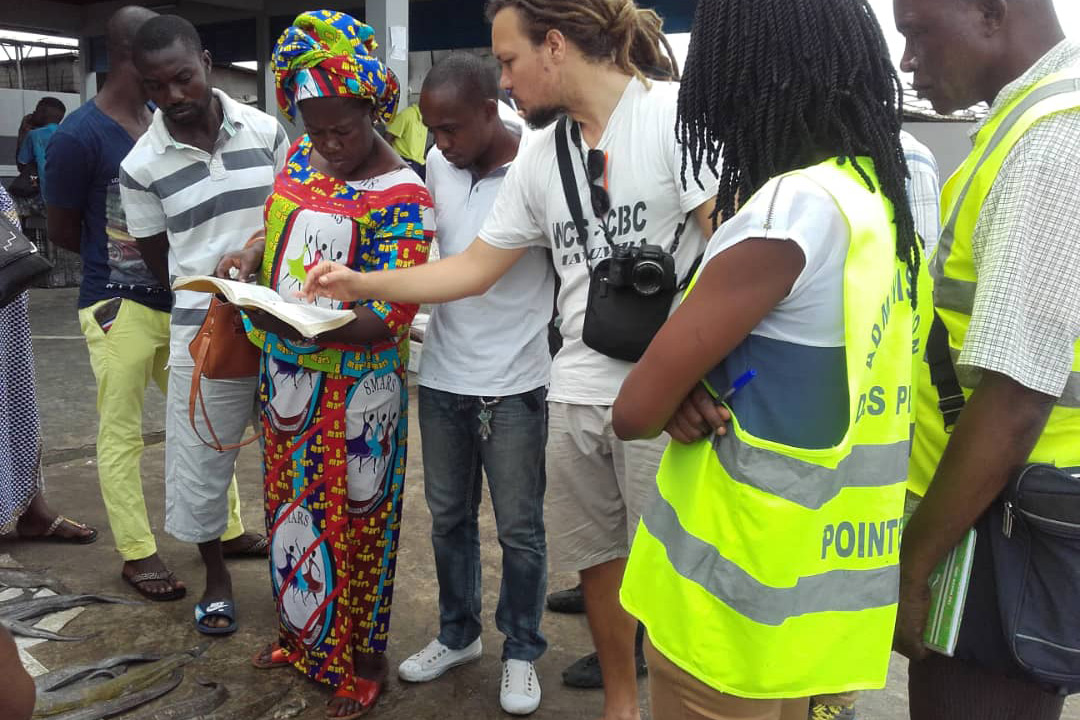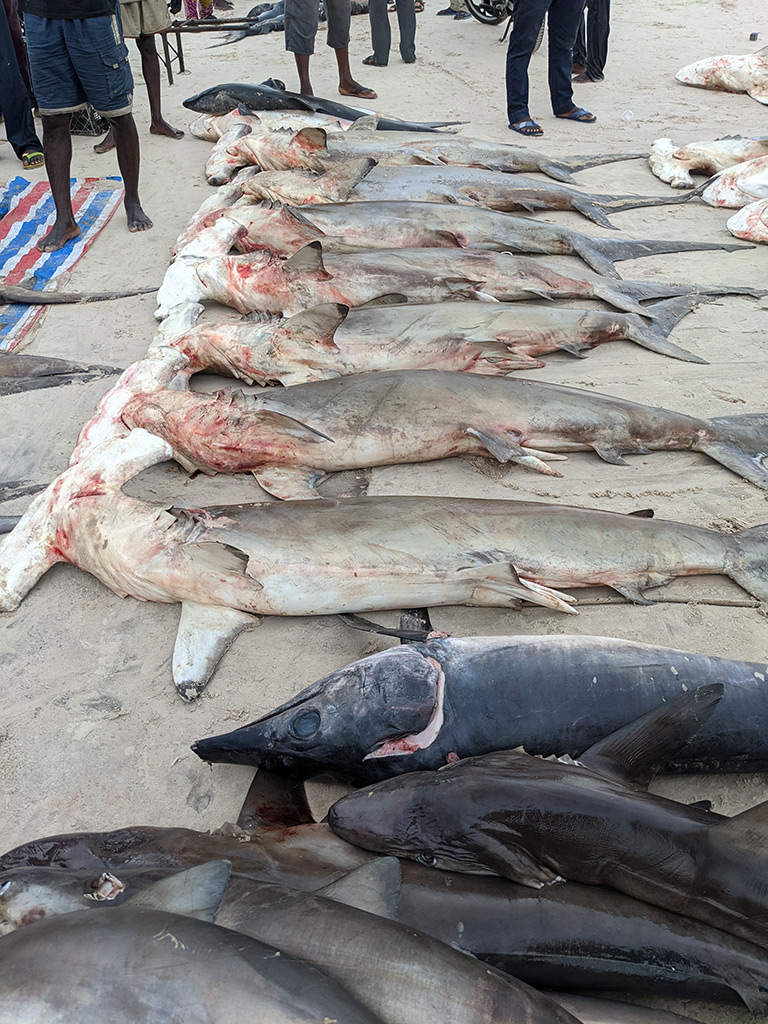A new shark census off the coast of the Republic of the Congo relied on hard-earned trust between researchers and artisanal fishermen.The team found endangered sharks and rays on potential nursery grounds, including juveniles and two species thought to be gone from the region.The authors recommend conservation strategies to protect endangered species without harming the livelihoods of Congolese fishermen.
The Republic of the Congo is a hotspot for sharks and rays. However, scientists didn’t know how many of these species congregate along the coast until they asked the artisanal fishermen who work there. In a recent study published in Conservation Science and Practice, researchers from the University of Exeter in the U.K. worked alongside local partners in the Congo to unveil many surprises among the fishermen’s catches.
During the three-year study at Songoro, the country’s largest landing spot for the small fishing vessels called pirogues, researchers documented more than 73,000 individual sharks and rays. The census tallied 42 different species, 34 of which face an elevated risk of extinction, according to the IUCN Red List. The fishermen also showed scientists two species that they previously thought were gone from the region: the African wedgefish (Rhynchobatus luebberti) and the smoothback angelshark (Squatina oculata).
A mako shark (Isurus oxyrinchus) caught at Songolo. Credit: Godefroy De Bruyne
The team credits the project’s success to long-term relationships with locals and a protocol designed to minimize disturbance to their daily fishing activities. After establishing partnerships with the Wildlife Conservation Society’s Congo Program and the Pointe Noire Artisanal Fishery Support Centre at Songoro, researchers asked fishermen for permission to handle, measure, and weigh the sharks they caught.
“It was successful because it was led by their priorities, rather than academic priorities,” says senior author Kristian Metcalfe, a conservation scientist at the University of Exeter. Metcalfe has worked in the region for more than a decade, and nine of his 13 coauthors live and work in the Republic of the Congo.
Conservation biologist David Shiffman at Arizona State University in the U.S., who was not involved in the study, applauds the team’s enterprising work. “This sort of data is invaluable for conservation and management,” he said. “In regions with limited marine biology research vessels, we can’t be patrolling every inch of the ocean.”
 An artisanal fishing boat called a pirogue unloads at Songoro after a fishing trip. Credit: Godefroy De Bruyne
An artisanal fishing boat called a pirogue unloads at Songoro after a fishing trip. Credit: Godefroy De Bruyne A training session between the Wildlife Conservation Society and the Fishing Administration at Songolo. Credit: Baudelaire Dissondet
A training session between the Wildlife Conservation Society and the Fishing Administration at Songolo. Credit: Baudelaire Dissondet
Attempts to ban shark fishing only drive the industry underground and create mistrust between citizens, legislators, and scientists, the authors stated. Conservation strategies must protect both endangered species and the people who rely on sharks for protein and income, Metcalfe said.
The team suspected the region might be a nursery ground after finding many smaller sharks on catch piles, some even with umbilical cords still attached. “Pregnant females, when they are landed on the boat, will sometimes give birth, and the fishermen, through necessity, will land everything,” Metcalfe told Mongabay. The research team spoke with the fishermen about why tossing juveniles back in the water helps keep populations healthy and will lead to more viable adults in later years.
To avoid catching juveniles and specific endangered species, fishermen could switch up their gear, the authors recommend. “If you catch sharks with nets, they are almost always dead because they have to move to breathe,” said coauthor Godefroy De Bruyne, marine coordinator for the Wildlife Conservation Society in the neighboring nation of Gabon. “If you use the line, you have a higher chance of being able to release the sharks you don’t want.”
 A catch of sharks landed at Songolo in the Republic of the Congo. Credit: Godefroy De Bruyne
A catch of sharks landed at Songolo in the Republic of the Congo. Credit: Godefroy De Bruyne
The Congolese government might opt to close fisheries during vulnerable shark and ray reproductive seasons. But Congolese fishermen would then need either a higher price for each individual shark, or other options to earn income. For instance, said De Bruyne, “That could be organizing whale watching or sport fishing trips, or raising cattle and chickens.” With continued teamwork and a more balanced economy, the sharks and rays off the Congolese coast can thrive, the authors concluded.
“If conservation scientists want to have an impact, we can’t just drop in, do a study, and leave,” Metcalfe said. “We have to invest in the long term. I don’t want to walk away from all the relationships and trust that we have built now, because I feel like we are at the cusp where we can actually make a change.”
Header image: An African wedgefish (Rhynchobatus luebberti) landed by artisanal fishermen and sold in Songolo (Critically Endangered, IUCN Red List). Credit: Godefroy De Bruyne
Molly Herring is a graduate student in the Science Communication M.S. Program at the University of California, Santa Cruz. Other Mongabay stories produced by UCSC students can be found here.
Citation:
Doherty, P. D., Bruyne, G. D., Moundzoho, B. D., Dilambaka, E., Okondza, G. N., Atsango, B. C., Ngouembe, A., Akendze, T. R., Parnell, R. J., Cournarie, M., Malonga, R., Missamou, A., Godley, B. J., & Metcalfe, K. (2023). Artisanal fisheries catch highlights hotspot for threatened sharks and rays in the Republic of the Congo. Conservation Science and Practice, 5(11), e13017. doi: 10.1111/csp2.13017
Animals, Conservation, Endangered Species, Environment, Fishing, Green, Oceans, Rays, Sharks, Sharks And Rays, UCSC, Wildlife
Africa, Atlantic Ocean, Central Africa, Congo, Republic of Congo
Source link : https://news.mongabay.com/2023/11/congos-waters-are-hotspot-for-endangered-sharks-and-rays-reveals-data-from-artisanal-fishers/
Author :
Publish date : 2023-11-28 08:00:00
Copyright for syndicated content belongs to the linked Source.





